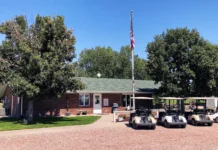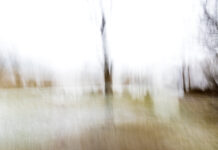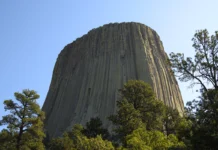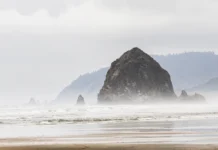| NEBRASKA |
Most visitors to Scottsbluff, Nebraska arrive looking for history and the experience of walking along the Oregon, California, and Mormon Trails following the footsteps of their ancestors, and other immigrants, to new lives in the late 1800s. No consideration is given to one of seven land-locked lighthouses in the United States that they can only see in the panhandle of Nebraska and honestly, no one cares.
Article & Photography by: Hawk Buckman
During visitors’ stays in Morrill, Scotts Bluff, Banner, Kimball, and Sioux Counties many will explore the surrounding areas such as Signal Butte, the North Platte River, the Scottsbluff Zoo, Roubadeaux Pass, the Roubadeaux Trading Post, and other locations of interest in and around the Platte River Valley.
One location that should be seen while visiting western Nebraska is the Lake Minatare State Recreation Area (the Panhandle’s largest body of water) and the full-size Lake Minatare Lighthouse- a land-locked folly lighthouse that has stood at Lake Minatare since 1939. The lighthouse has never been functional but has stood for years as a symbol of Nebraska and the Nebraska Panhandle, much like Chimney Rock.
The structure was constructed to resemble a lighthouse but is a pavilion, shelter, and picnic area built by the Veterans Conservation Corps, a New Deal agency that provided jobs to unemployed veterans in the 1930s.
The Folly Lighthouse is one of seven inland lighthouses in the United States and was constructed out of native stone. It’s located in the middle of Lake Minatare, which encompasses 2,158 acres and stands in the center of the North Platte Wildlife Refuge. The lake was created between 1912 and 1915 when the construction of Minatare Dam was completed. Minatare Dam is a historic structure and was determined to be eligible for the National Register of Historic Places.
Camping and boating facilities are available at Lake Minatare recreation area, a modern campground featuring asphalt pads with electrical hookups on the west end of the campgrounds. Modern restrooms, showers, and water hookups are available. There are 100 primitive camping areas around the lake accessible by car or truck. But be careful not to get stuck in the sand. Picnic tables, shelters, drinking water, fire grates, a trailer dump station, and vault toilets dot the landscape and are within walking distance or a short drive.
On October 2, 2012, Stephen Colbert released his book “America Again: Becoming the Greatness We Weren’t.” Astonishingly, the Lake Minatare Lighthouse was pictured in the publication as a reference to the distance between New York, NY, and Scottsbluff, NE, and how the United States had changed since the use of security cameras and other tactical means had been developed since 9/11 to observe the terrorist activity. The comment was satirical and harmless.
When visiting western Nebraska, visit the lighthouse and Lake Minatare. However, be sure to do so before Oct 15 and after Jan 15, as the lake is closed to the public to host migrating waterfowl and wildlife.
A Nebraska State Park Permit is required to enter the parking area. A daily pass can be purchased for $6. Nebraska-platted vehicles (residents) can buy a yearly permit for $30. Out-of-state vehicles can purchase an annual pass for $45.
||| DIRECTIONS
From Scottsbluff: The intersections of Hwy. 71 and Hwy. 26, go three miles north on 71 to Lake Minatare Road. Turn east on Lake Minatare Road and go eight miles to a T at Stone gate Road. Turn left (north) on Stone gate Road for one mile. Turn right into the Lake View entrance immediately after crossing the canal bridge. The office is ½ mile on your right.
From Minatare and Hwy. 26: Turn north on Stone gate Road at the Northeast corner of Minatare. Go nine miles following Stone gate Road to the Lake View entrance, turning right after crossing the canal bridge. The office is ½ mile on your right.
GPS Info. (Latitude, Longitude):
41.93306, -103.49556
| REFERENCES
The information in this article has been compiled from:
- Jerry Lucas – VOL Federal Parks Service
- Scottish Mining Records
- Murdoch Family































